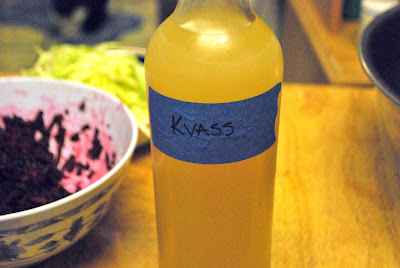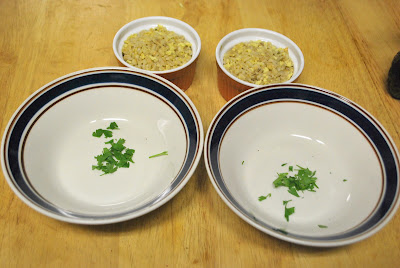On our next installment of To Russia, With Love, a celebration of my Russian spam-bot visitors that have finally boosted me over 10,000 visitors since Mr. Onion's Neighborhood's first recipe post is a traditional recipe for borscht, we'll be making a wonderful soup of beets and cabbage.
Borscht (also spelled as borschsh) was likely made as a means of making use of root vegetables that were nearing the end of their shelf life. After a pot was collected, some kind of stock was added to the pot and it was cooked up make use of any leftovers. While borscht is considered to be a Russian recipe, its roots are in the Ukraine.
Speaking of roots, the main root vegetable used in borscht is beets. Beets are wildly underrated. These wonderful root vegetables, originally praised only for their chard-like greens before the value of their roots were found to be delicious are wonderfully full of vitamins and antioxidants.
There are a wide variety of borscht recipes out there, each one claiming to be more traditional than the next. Over at Food Timeline, they quoted a recipe from Classic Russian Cooking: Elena Molokhovets' A Gift to Young Housewives from 1861, which is the recipe we'll be following. Old recipes are often the most basic and give us a great platform from which to personalize our own versions of the dish. You'll notice a lot of modern recipes (or some claiming to be traditional) are based on this very simple yet delicious recipe.
Perepare bouillon #1 from 3 lbs of fatty beef or fresh pork, or from beef with smoked ham. Omit the root vegetables, but add a bay leaf and allspice. Strain the bouillon. An hour before serving add a little fresh cabbage, cut into pieces. Cook, stirring in beet brine or grain kvass to taste or about 2 spoons vinegar. Meanwhile thoroughly wash and boil 5 red beets, but do not peel or cut them; that is, boil them separately in water without scraping. Remove them when tender, peel, and grate. Stir 1 spoon of flour into the beets, add them to the bouillon with some salt, and bring to a boil twice. Put parsley in a soup tureen (some people add the juice of a grated raw beet) and pour in the hot borshch. Add salt to taste. Sprinkle with black pepper, if desired, and serve with the sliced beef, pork, or ham; or with fried sausages, meatballs, or mushroom buns. The borshch may also be served with fried buckwheat kasha, pancake pie with beef stuffing, or plain pancakes.This recipe has two distinct parts: the stock (our bouillon) and the vegetables.
It's possible that the author is referencing a specific bouillon recipe when she says "bouillon #1": since I do not own the book and since Google Books only had a portion of the book available for previous, I'll assume the bouillon is as the recipe states.
- 3 lbs. meat (beef, pork)
- water
- 5 allspice berries
- 2 bay leaves
- salt
This can be done well ahead of time. I used a couple of meaty shank bones and some smoked ham hocks we had in the freezer. Fill a pot with about a gallon (four quarts) of water and bring to a boil. Add in the meat and spices, cover, and simmer for about 3 to 4 hours. If the liquid looks low, add another quart or two of water. Strain, reserve any meat (optional), and store in the fridge.
For a more modern take, you can add some aromatics like celery and carrots, and can improve on the flavor profile with some additional savory herbs. I found the allspice berries to have little effect on the overall flavor, and added a second bay leaf halfway through the cooking. Another way to improve the flavor would be to roast the bones in the oven before making the stock.
Remove the stock from the fridge and skim off any fat that has solidified on top of the stock. Depending on which meats you put into the stock, it may have gelled. No worries! As soon as heat is applied it'll return to a liquid. Place in a pot over low heat and allow to warm up.
- 1/4 cabbage, shredded
- 3 beets
- 1 quart water
- white pepper
When cutting beets for storage always leave a little bit of stem on the beet. They say this will help them maintain color.
Put three beets into a separate pot, cover with water, and bring to a boil. Allow the beets to boil for about an hour. Use a skewer to poke into the center of the beet. The beets are finished boiling when it is relatively easy to poke the skewer into the beet. Drain and set aside to cool.
Shred the cabbage. To do this, first cut the cabbage in half (from the top, not the side), then divide one half into two pieces. From one quarter, slice off the core (the solid white part) and then cut into very thin strip. Toss this in with the stock. If you made some kvass from my previous recipe, add some to taste. I ended up using about a cup of kvass, but depending on the strength of its flavor you may need more or less. Instead of kvass you could use some vinegar; I assume apple cider vinegar would work well since it has a somewhat similar flavor profile to kvass.
After the beets are cool, use a small knife or peeler and remove the tough outer skin of the beet. Shred the beets. There is no way around it: your hands, cutting board, bowls and sink will make it look like you murdered a Muppet. Beet juice can stain, so don't do this dressed in your Sunday best!
Mix a hefty tablespoon of flour in with the shredded beats.
By now your stock and cabbage should have been simmering for about an hour. Check and make sure the cabbage is cooked. It should have a bit of a crunch to it, but be somewhat tender.
Increase the heat slightly and add in the beet/flour mixture. Bring to a boil, skimming off any foam that comes up, then cut the heat for a few minutes. Add in any leftover meat (shredded or chopped) from when you made stock and bring to a boil again, skimming any foam. Add some salt a little bit of pepper (we found white pepper to work well) and then cut the heat and allow it to rest.
To serve, put some diced parsley in a bowl then ladel a couple of good spoonfuls into the bowl. While I could not find any smetana, we did have some sour cream and added a big dollop. It was pretty fantastic! The beet flavor wasn't overpowering, and the stock gave it a nice meaty flavor. I made some fried kasha as a side dish (hint: you may see this in an upcoming post) but any kind of grain or carbohydrate would go well with the borscht.
I'm always surprised that sometimes the most simple recipes yield the best results. You can add other root vegetables to this, extra meats and vegetables, or whatever else you might have handy. We added some egg noodles to help stretch the leftovers the next night: wonderful stuff!
Enjoy!









I will definitely be bookmarking this recipe, as this one is on my list! Thanks for the play-by-play; I'm sure I'll need all the help I can get when I try to make it :)
ReplyDeleteSaw your comment on another blog..to answer your question..you can also "Bake" sweet potatoes (wrapped in tin foil) wait for them to cool and then bag them, put them in the freezer..take out as many as you want, let them get to room temp. and then take off the tin foil, slice them in half, add butter and microwave until hot :o) hope this helps.
ReplyDeleteAnthony! This is great! We have so many beets and not enough recipes.
ReplyDeleteRemember to include your website when you comment on my site- my peeps will love this.
Thanks for the shout-out, Molly!
ReplyDeleteI liked how basic this recipe was (despite the many steps). Very few ingredients, and very, very flexible. Traditional borscht, I read, was more of a combination of whatever root vegetables were leftover. They'd throw them in a pot and when the pot got full just add some meat and water (or maybe stock) and toss in some other vegetable "leftovers".
I'd like to try this with maybe some turnips or parsnips added. I think they'd make good additions. :)
I'm making my borscht tomorrow! (Although I found a slightly different recipe- Ukrainian) Wish me luck :)
ReplyDelete